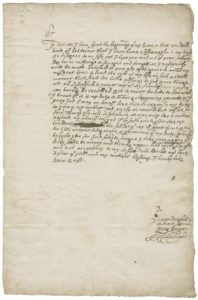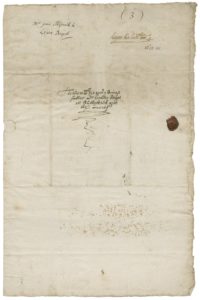Hear ye, hear ye! Step right up (virtually), and view transcriptions and images of English manuscripts from many centuries past!
An image of a page in a letter (L.a.67) from the Papers of the Bagot Family
January 2017 marks an exciting new phase in the development of Early Modern Manuscripts Online (EMMO). A number of letters and family papers from the manuscript collection at the Folger Shakespeare Library are now viewable and searchable via the web. Images and metadata are combined with full transcriptions on the site to provide users with a new kind of interaction with these rare materials.
Having complete transcriptions available is a major step forward in manuscript studies since transcriptions serve as a bridge, allowing people without advanced training in paleography to explore these fascinating documents from the sixteenth and seventeenth centuries. EMMO offers three flavors of transcriptions for each manuscript image: diplomatic, semi-diplomatic, and regularized. Most prefer semi-diplomatic transcription for scholarly work as it has well-established conventions and makes only slight alterations for modern readers (with changes shown in italics); such alterations include expanding common abbreviations (e.g., lres would become lettres) and replacing archaic brevigraphs such as the thorn (e.g., ye would become the). The often creative original spelling of words in the manuscripts is maintained in semi-diplomatic transcriptions as are any deletions (cross-outs), insertions (words written above or between lines), and marginalia (words written in the margins). The other two flavors of transcriptions included on the EMMO site are diplomatic and regularized. The diplomatic transcription is a rendering without the expansions and replacements of the semi-diplomatic version; it also retains the superscript letters that appear frequently in manuscripts (such letters are silently lowered in the semi-diplomatic one). In point of fact, the best diplomatic version is the image itself, but the EMMO diplomatic transcription, albeit limited, provides a sense of the image in legible text. A version with regularized spelling is also available for viewing and accessible for online searches. Users will have the option to download the semi-diplomatic transcriptions as PDFs. Users may also download the XML of the encoded transcriptions.
This first batch of manuscripts for the beta is comprised of an assortment of family papers from various Folger shelfmarks. Works by John Donne are here (from the Loseley Collection) and also correspondence concerning the Bagot family (from the Papers of the Bagot Family), letters from or to Lady Ferrers (from the Papers of the Ferrers Family), and documents pertaining to Nathaniel Bacon and members of the Townshend family (from the Bacon-Townshend Collection).
To provide users with a more comprehensive sense of these documents, images and transcriptions for all pages of the letters are shown, not only the pages where the main body text of the letter appears (as in the first image above) but also the address leaf of that letter (see image below) and the essentially blank pages.
Seeing all sides of the letters, as it were, presents all of the text and surfaces involved, fostering a more thorough appreciation of these manuscripts.
More letters will be coming to the EMMO site as the beta test progresses and also additional genres of manuscripts from the Folger’s vault including receipt (recipe) books, miscellanies, literary works, legal documents, illustrated works, coats of arms, etc. Various enhancements to the EMMO site will be added as well such as research guides, paleography learning aids, teaching plans, authority files, and advanced searching options.
As with any beta, this project site is under development during the testing period, though it will be stable enough for regular usage by researchers. Enhancements in functionality and new features will be added in the coming weeks, and further batches of vetted manuscripts will flow in on a regular basis. Watch for announcements about all of this information and other points of interest regarding the manuscripts here on the news page.
Of course, we welcome your feedback about the site in general and particularly any specific thoughts on site design, navigation, ease of use, bugs, and the transcriptions themselves. To give feedback or ask questions, use the comments feature.
The EMMO site will officially launch later in 2017. We expect it to grow during the months (and years) ahead. Eventually, the EMMO site will be integrated into a larger online platform at the Folger with other digital assets and projects as we continue to build a research library for the twenty-first century.
Again, welcome! We look forward to your participation in this exciting stage of the EMMO project. Huzzah!

